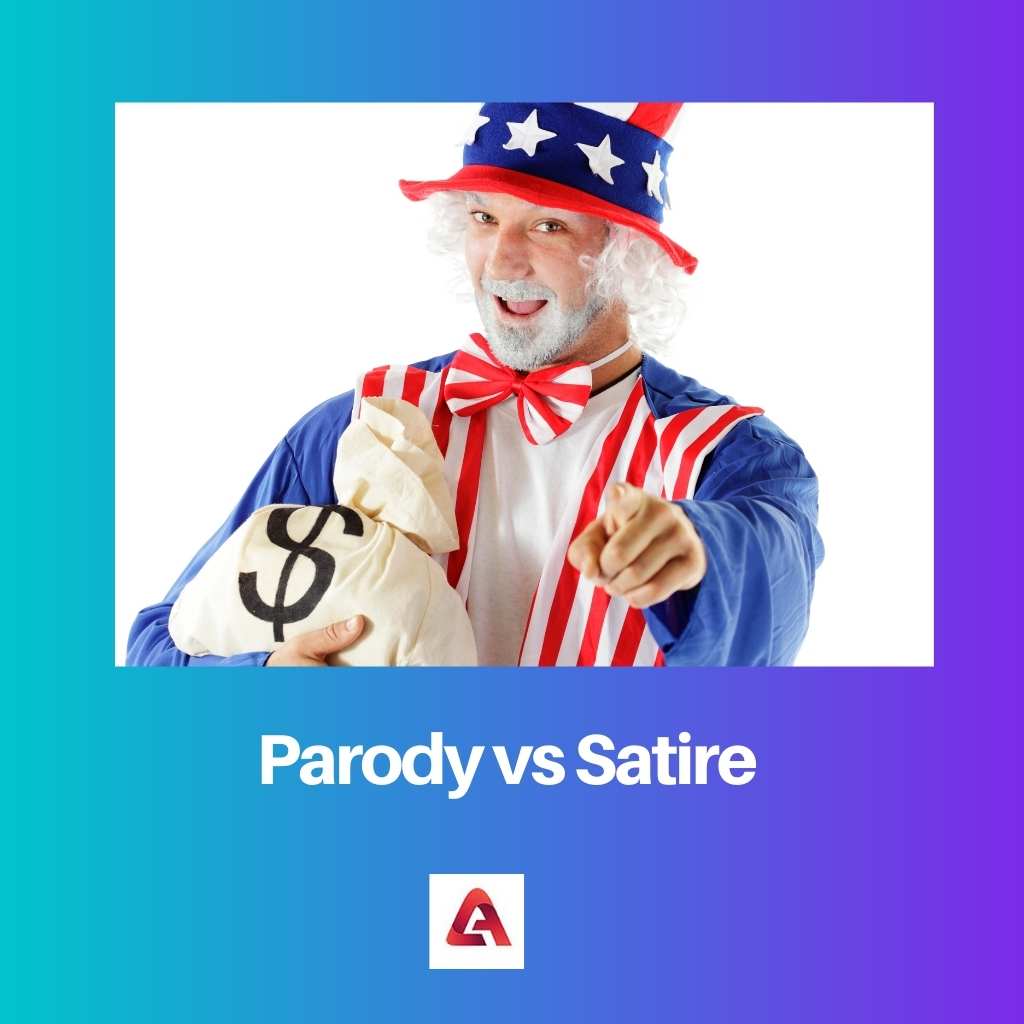Parody and satire are two vital literary genres. Both the genre seem similar and are considered as same out of confusion.
However both parody and satire have different purposes and functions, and the implementation technique is also different in both genre types. Both have distinct differences in them.
Key Takeaways
- Parody imitates and exaggerates a specific work or style for comedic effect, while satire uses humor, irony, or exaggeration to critique or expose human flaws or societal issues.
- Parodies target specific works, whereas satires address broader topics or issues.
- Both parody and satire use humor as a tool, but parody focuses on entertainment, while satire aims to promote change or provoke thought.
Parody vs Satire
Parody is a humorous imitation of a work, using exaggerated or distorted elements for comedic effect. While Satire uses humor to criticize or tell flaws in society, politics, or other topics. Parody is a comedic imitation, while satire is a form of social commentary that uses humor as a tool.

The creation of parody is mainly for entertainment purposes. The end goal is to make the audience and the spectators have a good laugh.
Parody involves deliberate exaggeration in the presentation of the concept which provides a comic effect to the work.
While the creation of satire is mainly for delivering a social message and bringing awareness about a particular concept or subject.
The end goal is to expose the weaknesses and follies and make the audience think about the same.
Comparison Table
| Parameters of Comparison | Parody | Satire |
|---|---|---|
| Definition | Parody refers to the mimicry of the work or style of another author or artist | Satire refers to the criticism through humor about the various weaknesses and corruption in a community or society |
| Purpose | The purpose of parody is to cater for entertainment | The purpose of satire is to cater to realization and expose the issues |
| Other names | Send- up, spoof, and lampoon | Social criticism |
| Origin | The basis of parody is on the work of some other creator or can be even based on a person | The basis of satire is not on the work of some other creator artist or author |
| Criticism | Parody can mimic people, novel song character literary art, or even a film | Satire can criticize an entire community society, government, or system at large |
What is Parody?
Parody refers to a literary work or a style of writing that involves imitation of the style of someone or something in a way that amuses the readers.
Parody incorporates the frame which is set up by some original idea and adds some humorous and comic elements in the same frame of the idea.
The most vital literary element that is extensively used in parody is a deliberate exaggeration. The flaws in the existing work are exposed and exaggerated or can even be trivialized.
Parody is not only incorporated in literary works but can also be used in music films series TV shows, and other genres.
The most renowned example of parody is Pride and Prejudice and Zombies by Seth Grahame-Smith. It is written on the original plot of pride and prejudice by Jane Austen.
The plot, characters, sequence, and even the writing style are the same as the original framework of Austen but the introduction of zombies in the plot is an example of parody.
Some examples of parody films are “Vampires Suck” which is based on twilight written by Stephanie Meyer, “Robin Hood: Men in Tights” which is based on the films of Robin Hood.
Such films intend to mock the storyline and also provide entertainment to the audience.
What is Satire?
Satire refers to a style of writing which is inculcated by various writers and authors to criticize certain subjects. The derivation of the word satire has been from a Latin word called “satura”.
The meaning of the Latin word is a poetic medley. Satire involves key components of exaggeration, irony, and humor.
The usage of the word satire can not only refer to the style by which certain concepts of society are criticized through humor but also refers to the work which is created by incorporating that style of writing.
Through satire, a system, community, society, or even a certain group of people can be ridiculed and exposed.
The aim of using satire in a composition is to expose and highlight the weaknesses and the follies that are present in society.
The entire presentation consists of laughter and humor, but the end goal and aim of the presentation is to make the readers realize the vices and corruption that could be weakening the society.
Satire is also commonly termed and known as social criticism.
To incorporate satire in the work, the authors use various literary techniques like euphemism, irony, understatement, exaggeration.
Some renowned examples of satirical work are Animal Farm by George Orwell, Gulliver’s Travels by Jonathan Swift, Voltaire by Candide, and numerous others.
Main Differences Between Parody and Satire
- Parody brings a comic effect in the composition while satire may not include any comic effect in the composition.
- Parody may or may not try to improve humanity and other institutions while satire extensively focuses on improvement of humanity and other institutions.
- Parody introduces inappropriate subjects in the composition while satire introduces irony in the composition.
- Parody imitates mimicry writing style or storyline of some other composition while satire does not imitate and can have complete originality.
- Parody involves a surface-level mimicry with little lasting impact while satire involves deeper-level mimics and intends to have a higher-lasting impact.
- The vital part of parody is echoic mention while the vital part of satire is pretense.

- https://journals.sagepub.com/doi/abs/10.1177/0002764213506213
- https://www.tandfonline.com/doi/abs/10.1207/s15327868ms0802_2
